



Part of The Treaty of Finsbury Park 2025
The Treaty of Finsbury Park 2025 is an immersive fiction that looks at what it would be like if other species were to rise up and demand equal rights with humans. For 5 years human park-lovers have taken part in this fiction by playing for and as another species (so, like, NOT as a human ok?!).
From October 2024, you can scan the hoardings that wrap Furtherfield Gallery in Finsbury Park to watch highlights from the 2023 Interspecies Festival. You can also access the the magical Finsbury Park Sentience Dial app to make a pledge that advances interspecies justice and blooming biodiversity!
Now you can be among the first to pledge your support for a cooperation agreement between ALL living species in Finsbury Park.
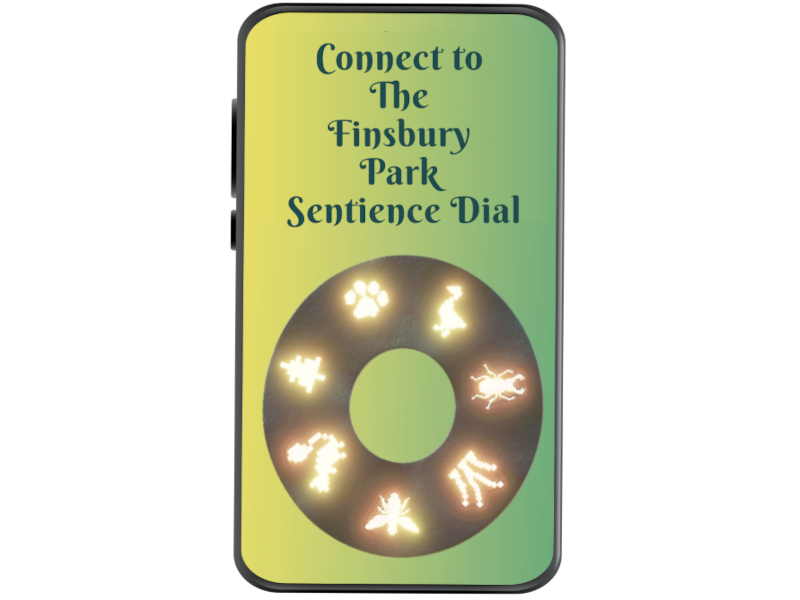
Biodiversity is crucial in reducing the harmful effects of climate change, and city parks have a huge part to play. But it’s not all about us humans! Think like a dog, bee or even grass and help change the way we all see and participate in our local urban green spaces forever! It’s time to spark new ways of being, feeling and acting together!
Will you…
⏳ Saturday 28 and Sunday 29 September 2024
🏡 Furtherfield Gallery, at the McKenzie Pavilion, Finsbury Park, London N4
🐕🌳Exhibition and Treaty Signing activities 11 – 4pm
🎟️🐿️ Multi-species Meditation sessions – DAILY at 11am, 2pm and 3pm.
Join us for fun with family and friends in Finsbury Park to connect with park life in fantastical new ways.
🎟️🐿️ Book your free place for a Multi-species Meditation session led by Scirius the cockney squirrel, played by Human artist Max Dovey. Use your imagination to transform into another species with a totally different sense of what is important. Sessions daily at 11am, 2pm and 3pm.
🌳Use the magical new Finsbury Park Sentience Dial app to tune into all flora and fauna! Scan the park and meet up to 7 local park species representatives, then make your pledge for bountiful biodiversity!
⇨ Watch Tracy Kiryango’s short docu-fiction film The Interspecies Festival of Finsbury Park 2023 celebrating the cultures and talents of ALL Finsbury Park’s species, and using camera, lighting and post-production effects to convey multi-species-perspectives of the festival events.
⇨ Join the Multisensory Mystery Tour to see, hear and smell the old forest through the sensory superpowers of squirrels, trees, and dogs…
⇨ Hear the squeaks, squawks, howls and honks of the Multispecies Choir and their “songs” of lament, celebration and protest…
⇨ Sample delicacies from Pass-The-Poop-Parcel, the multi-species gastronomy game…
Help shape the first-ever interspecies treaty of cooperation for bountiful biodiversity!
Don’t worry! From October 2024, you can scan the hoardings that wrap Furtherfield Gallery in Finsbury Park to watch highlights from the 2023 Interspecies Festival. You can also access the the magical Finsbury Park Sentience Dial app to make a pledge that advances interspecies justice and blooming biodiversity!
The Treaty of Finsbury Park 2025 depicts the story of the dawning of interspecies democracy. It’s a new era of equal rights for all living beings, where all species come together to organise and shape the environments and cultures they inhabit – in Finsbury Park, and urban green spaces across the UK, the world, and beyond!
Based around a set of live action role play games – or LARPs – the Treaty of Finsbury Park 2025 is played from more-than-human perspectives to encourage the blooming of a bountiful biodiversity and interspecies political action.
Like many urban parks, Finsbury Park is fraught with environmental issues from noxious gases and traffic noises to governance struggles and financial sustainability. The pledges are based on research collaborations and prioritised with participants. Find out more about the story so far, the research, and the importance of biodiversity in urban green space by visiting our FAQs.
The Treaty of Finsbury Park 2025 is a major collaborative project led by Furtherfield, exploring new ways to build empathy pathways to non-human lifeforms through play.
It represents a major undertaking to do long-term work exploring how an arts organisation based in the heart of an urban green space can support a deeper understanding of that green space and ALL its inhabitants. Beginning in 2020 and spanning a minimum of 5 years, the work was originally developed in collaboration with The New Design Congress. The first 3 years are being supported by CreaTures (Creative Practices for Transformational Futures). CreaTures project received funding from the European Union’s Horizon 2020 research and innovation programme under grant agreement No. 870759. The content presented represents the views of the authors, and the European Commission has no liability in respect of the content.
View full credits
“In The Treaty of Finsbury Park 2025, we are catapulted several years into the future where all the species of the park have risen up to demand equal rights with humans. After much unrest, it has been agreed that a treaty will be drawn up, designating these rights, but first humans must learn to better relate to and understand non-humans so they can cooperate better together. Thankfully there has been a new invention – The Sentience Dial – which allows humans to tune into all the flora and fauna of Finsbury Park.”
WHAT’S ON NOW: THE TREATY SIGNING
The Treaty of Finsbury Park 2025 is a collaborative project that depicts the story of the dawning of interspecies democracy. It’s a new era of equal rights for all living beings, where all species come together to organise and shape the environments and cultures they inhabit, in Finsbury Park (and urban green spaces across the UK, the world, and beyond!) Like many urban parks, Finsbury Park is fraught with environmental issues from noxious gasses and traffic noises to governance struggles and financial sustainability. If colonial systems of dominance and control over living beings continue we all face an apocalypse.
Based around a set of LARPs – or live action role play games – the Treaty of Finsbury Park 2025 is played from more-than-human perspectives to encourage the blooming of a bountiful biodiversity and interspecies political action. Think like a dog, bee or even grass and help change the way we all see and participate in our local urban green spaces forever.
There are 3 parts to the story.
Part 1. 2022. The Interspecies Assemblies – these are games where everyone gets to plan the Interspecies Festival of Finsbury Park 2023 – an event which will celebrate the drawing up of the treaty itself.
Part 2. 2023. The Vote – once artists have had a chance to gather everyone’s input they’ll present 3 proposals for the Interspecies Festival and everyone will be invited to choose the one they want to participate in.
Part 3. 2023. The Interspecies Festival of Finsbury Park – all the species of Finsbury Park will be invited to join the festival in Summer 2023.
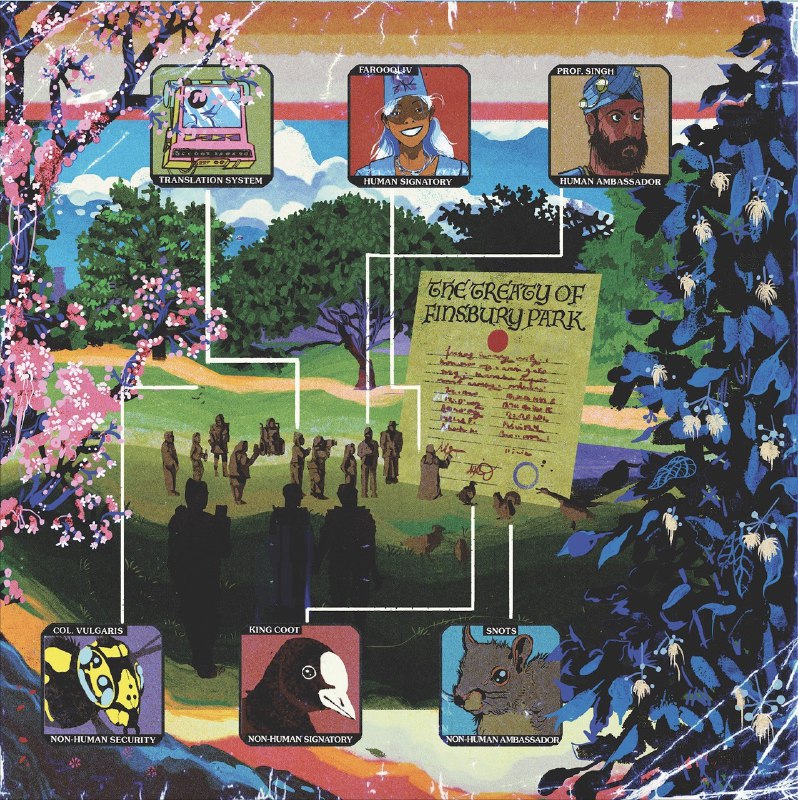
The Interspecies Festival will be a gathering for all species to showcase their cultures, their interests and talents. Like a World’s Fair or an Olympic Games, it will be a place of discovery, marvels and broadened horizons. But it can only be planned if you help all the species of the park present their ideas.
By planning the Interspecies Festival together, human people from the locality and around the world will build empathy pathways to other beings. They will learn about what matters to them and their habitats. They will explore what it would mean to acknowledge the equal rights of more-than-human beings to the same range of freedoms they expect for themselves. They will draft the Treaty and they will decide how to connect even more deeply with all the species of the park through a festival for all. From September 2022 scannable hoardings will wrap the Furtherfield Gallery in Finsbury Park with an exhibition featuring stories about the new knowledge and relationships formed by assembly members for the benefit of biodiversity locally and world wide.
In the PUBLIC game of ‘Interspecies Assemblies’, human players will be partnered with a mentor representing one of 7 species based in Finsbury Park. These include a tree, a bee, a goose, grass, a squirrel, a stag beetle and a dog. Players will be tuned into the mentor’s needs and experiences1 and will then represent them at a series of online assemblies being held to choose the events and the location in the park for the first ever Interspecies Festival of Finsbury Park.
PLAY THE INTERSPECIES ASSEMBLIES GAMES ONLINE.
RECEIVE UPDATES ON THIS PROJECT.
In Spring 2022 The Interspecies Artists Forum will be commissioned to design a set of festival activities for 3 biodiversity habitats based on everything learned and proposed through the Assemblies. For example, the dogs might lead on the Sniffathon followed by Barkeoke, Name that Honk for the Geese, and the Squirrels present the Antique Nut Show. Different activities for different habitats will then be presented as immersive scenes for mobile phones for a public vote.
There will be a PUBLIC vote to decide which biodiversity habitat in the park will host the festival, based on the interspecies activities designed for it. We already know that the bees are abuzz for the wildflower meadows, the stag beetles dig the ancient forest, while the squirrels squeak for the new forests. But the winning habitat will need to appeal to all the species. From April 2022 scannable hoarding will wrap the Furtherfield Gallery in Finsbury Park. Everyone – human or otherwise – is invited to attend, scan, and explore activities in the proposed habitats and decide where the Interspecies Festival should be held to best serve the bountiful biodiversity of the park.
The final Interspecies Festival activities will take place in the chosen habitat to be further developed and enjoyed by the park’s public in the summer. These will take place alongside the presentation of the draft Treaty for discussion by all the human and more-than-human people of the park.
Read the concept paper here.
RECEIVE UPDATES ON THIS PROJECT.
The Treaty of Finsbury Park 2025 is a major new project exploring new ways to build empathy pathways to non-human lifeforms through play.
It represents a major undertaking to do long-term work exploring how an arts organisation based in the heart of an urban green space can support a deeper understanding of that green space and ALL its inhabitants. Beginning in 2020 and spanning a minimum of 5 years, the work was originally developed in a collaboration between Furtherfield and The New Design Congress. The first 3 years are being supported by CreaTures Creative Practices for Transformational Futures. CreaTures project has received funding from the European Union’s Horizon 2020 research and innovation programme under grant agreement No 870759. The content presented represents the views of the authors, and the European Commission has no liability in respect of the content.
Artistic Direction by Ruth Catlow
Concept by Cade Diem and Ruth Catlow
Visual design by Cade Diem
Illustrations by Sajan Rai
LARP Design and Hosting by Ruth Catlow, Bea Xu and Max Dovey
LARP Player Assistance by Yejide Cordner
LARP Player Support by Lekey Leideker and Tanya Boyarkina
Writing by Ruth Catlow and Dr Charlotte Frost
Music by Matt Catlow
Digital Mask animation by PopulAR
Research by CreaTures, stewarded by Dr Lara Houston and Dr Ann Light
Production support for prototype LARPs by Tanya Boyarkina
Outreach for prototype LARPs by Pita Arreola
Thanks to our first players: Shawn, Carien, Anne, Tom and Ricard.
Special thanks to Ricard, Finsbury Park Ranger for introducing us to all the different lives of the park
Thanks to all online Interspecies Assemblies players – you know who you are – 🐶 WOOF!
Opening Event: Saturday 13 October 2012, 1-4pm
co-hosted with The Festival of Mint – A Celebration of Local Growing – serving mint tea and mojito
Contact: info@furtherfield.org
DOWNLOAD PRESS RELEASE FOR PRINT HERE
+ See images of the exhibition on Flickr.
To be alive is to be wild. And we humans have a will that shapes the world with language, song, lust, labour and play. And for those of us who connect with it, a network of machines now extends our reach, amplifies our urges and quickens our exchanges.
The artists in this exhibition work and play with living organisms and technical things, systems and language, to explore how our relation to the natural world is changing. They introduce us to the unruly life going on in other natural webs of communication, knowledge and feral exchange. Gallery visitors (humans and dogs) are invited to view videos, interact with art installations and social media and undertake walks in the surrounding park with its other animals and edible plants.
Mary Flanagan travels overland and undersea in virtual worlds. Her journeys in the worlds are caught on video. Her avatar scouts the boundary lines of ‘heritage’ landscapes built by “residents”. Her walks are inspired by Thoreau, the great American writer and walker, who knew that ‘all good things are wild and free’.
![Aquitaine from the [borders] series by Mary Flanagan](http://www.furtherfield.org/wp-content/uploads/2012/08/borders-acquitaine-web.jpg)
Andy Deck calls attention to echoes of the wild in language. Despite the many entertaining digital visions of nature beamed to the flat screen, a wealth of intuitions relating to nature still survive in colorful expressions passed down for centuries. He invites you to help him build a bestiary of animal idioms using social media and a gallery installation.*
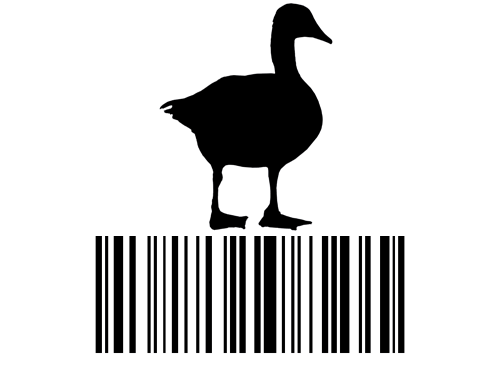
Sarah Waterson has invented a set of cartographic tools for dogs (and their human friends) to develop an interspecies psychogeography. Her electronic mapping system generates sniff data, routes and photographic journals supporting communication, collaboration and knowledge-sharing between companion species.
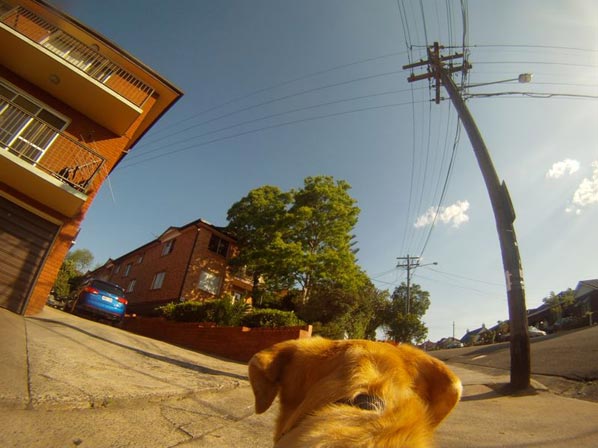
Helen Varley Jamieson and Paula Crutchlow dramatise the private actions and global consequences of our domestic lives in a long-running series of networked performances located in peoples’ homes. Dave’s Quiz (part 2) is an interactive extension of their provocation to discuss and appreciate relationships between personal, state and corporate responsibility around issues of consumption and disposal in late-capitalism.
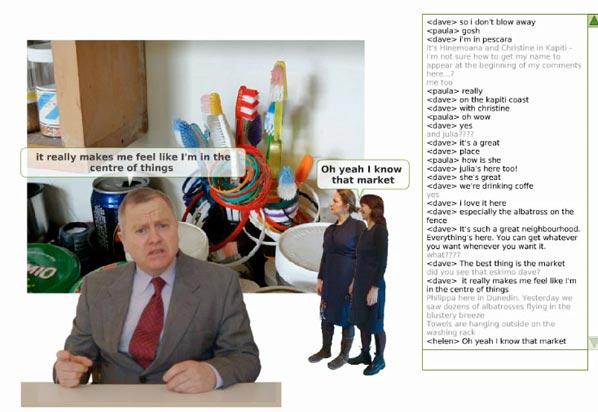
Artists duo Genetic Moo invite us to discover a dark, interactive sea of wiggling, luminescent creatures that gorge on torch light. They fantasize an evolutionary digression through the lens of human sensuality, drawing on images made by early scientists as they first found micro organisms or Animacules swarming in every sea, pond and pool of saliva.
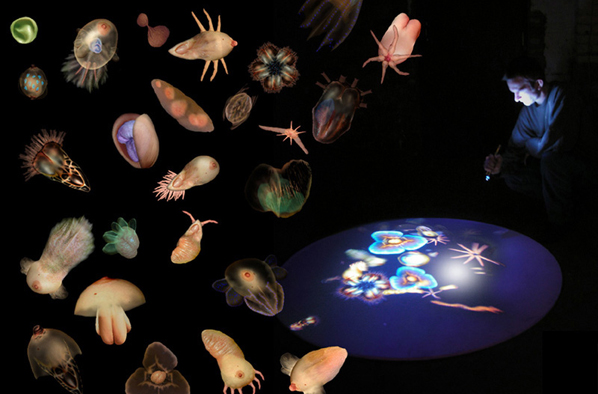
Disquieted by the environmental impact of constant technological upgrades, Dominic Smith works with open knowledge from the DIY mycology movement to create a system that combines the waste products from the tools and fuels of the contemporary coder. Out-of-date software manuals and coffee grounds are shredded to create a compost for fruiting oyster mushrooms to be harvested and consumed by visitors.**
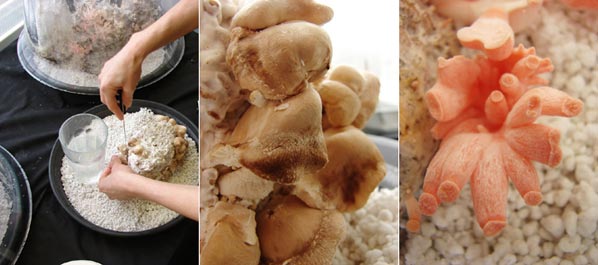
This exhibition is dedicated to Jay Griffiths, author of WILD: An Elemental Journey (2006).
* Crow_sourcing is a 2012 Commission of New Radio and Performing Arts, Inc. for its Turbulence website. It was made possible with funding from the Jerome Foundation. http://Turbulence.org/Works/crow_sourcing
** Dominic Smith developed this iteration of the shredder concept, originated by Julian Priest, David Merritt & Adam Hyde, as part of the geekosystem project. It is an experimental transposition of software development methods taking an organic, material form. It’s also worth noting that in his 1998 net art work Shredder 1.0 Mark Napier took the texts and images from pages of the WWW and jumbled them in colourful abstractions to reveal their ‘rawness’ once freed from the strict orthodoxies of web page design.
Crow_sourcing by Andy Deck
[borders] by Mary Flanagan
Animacules by Genetic Moo
make-shift: Dave’s quiz (part 2) by Helen Varley Jamieson & Paula Crutchlow
Shredder by Dominic Smith
Laika’s Dérive – The dogs de Tour by Sarah Waterson
Paula Crutchlow
Paula Crutchlow is a performance maker and director who co-authors live events across a variety of forms. As a co-founder and director of Blind Ditch she combines digital media and performance to engage audience and participants in distinct and active ways. Her work often uses a mix of score/script, improvisation and structured interaction to focus on boundaries between the public-private, and issues surrounding the construction of identity and the politics of place. Paula is currently the Creative Advisor for Adverse Camber directing work with some of the UK’s leading storytellers, she was an Associate Lecturer in Theatre at Dartington College of Arts, Devon 2001-10, and teaches Digital Performance Practice at the University of Plymouth.
Andy Deck
Andy Deck specializes in collaborative processes and electronic media. As a Net artist and software culture jammer, Deck combines code, text, and image, demonstrating patterns of participation and control that distinguish online presence and representation from previous artistic practices. In addition to numerous online exhibitions, his work has appeared in exhibitions like net_condition (ZKM), Unleashed Devices (Watermans Art Centre), and Animations (PS1-MoMA). He is also a co-founder of Transnational Temps, a media arts collective concerned with making Earth Art for the 21st Century.TM After showing in EcoMedia, a ground-breaking series of european exhibitions, Transnational Temps mounted the 2010 oil-related exhibition Spill>>Forward in New York. In 2011 Deck received first prize in the interactive division of the LÚMEN_EX Digital Art Awards. Deck’s work, currently shown by the Whitney Museum of American Art’s Artport and the Tate Online, has been commissioned by these and other prestigious institutions. Deck lives and works in New York City.
Mary Flanagan
Mary Flanagan is an artist focused on how people create and use technology. Her collection of over 20 major works range from game-inspired systems to computer viruses, embodied interfaces to interactive texts; these works are exhibited internationally at venues including the Laboral Art Center, The Whitney Museum of American Art, SIGGRAPH, Beall Center, The Banff Centre, The Moving Image Center, Steirischer Herbst, Ars Electronica, Artist’s Space, The Guggenheim Museum New York, Incheon Digital Arts Festival South Korea, Writing Machine Collective Hong Kong, Maryland Institute College of Art, and venues in Brazil, France, UK, Canada, Taiwan, New Zealand, and Australia. Her three books in English include Critical Play (2009) with MIT Press. Flanagan founded the Tiltfactor game research laboratory in 2003, where researchers create game interventions for social change.
Genetic Moo
Genetic Moo build living installations in pixels and light. The duo have been creating interactive art since 2008. Virtual creatures are constructed from choreographed video clips, combining elements of the human and the animal. They respond in a variety of life-like ways to audience motion, sound and touch and vary in size from the tiny Animacules to the all encompassing Mother. The works are driven using Open Source and Flash Software utilizing a variety of interactive interfaces. The programming behind the work is just complex enough to make the creatures appear more believable and create rich user driven narratives.
Schauerman and Pickup both gained Masters degrees from the Lansdown Centre of Electronic Arts. Their work has been exhibited extensively including the De La Warr Pavilion (2010); Watermans (2010) The Wellcome Collection (2011) and Glastonbury (2011). One of their works, Starfish, received a John Lansdown Award for Interactive Digital Art at Eurographics (2007) and was nominated for an Erotic Award (2012).
Helen Varley Jamieson
Helen Varley Jamieson is a writer, theatre practitioner and digital artist from New Zealand. In 2008 she completed a Master of Arts (research) at Queensland University of Technology (Australia) investigating her practice of cyberformance – live performance on the internet – which she has been developing for over a decade. She is a founding member of the globally-dispersed cyberformance troupe Avatar Body Collision, and the project manager of UpStage, an open source web-based platform for cyberformance. Using UpStage, she has co-curated online festivals involving artists and audiences around the world. Helen is also the “web queen” of the Magdalena Project, an international network of women in contemporary theatre.
Dominic Smith
Dominic Smith is an artist who engages with project hierarchy, ownership of ideas and heuristic curatorial strategies. Dominic is a founding member of ptechnic.org. He has exhibited and performed at Govett-Brewster Art Gallery in New Zealand, at the ICA in London, CCA Glasgow, AV Festival, Newcastle and Eyebeam NY. He has a doctorate with CRUMB at Sunderland University that examines the relationship between open source production methods, and art/curating methods. Dominic is also the current curator of thepixelpalace.org through which he also developed and runs basic.fm
Sarah Waterson
Sarah Waterson has practised as a new media artist for the past twenty years. Her works include electronic installations, collaborations with performers, video and audio work, generative and software based artworks, VR environments and data visualisations and ecologies. Interdisciplinary and collaborative practice informs the development and ultimately the design of these artworks. Her current interests include data mapping, data ecologies and cross species collaboration.
Sarah’s recent interactive installations have included: Laika’s Dérive (Performance Space, Carriageworks 2011), 33ºSouth (collaboration with Juan Francisco Salazar, Casula Powerhouse 2009), a custom made data mapping system that juxtaposes the cities of Sydney (Australia) and Santiago (Chile) trope, a e-literature project developed for the Second Life environment (SWF 08, ongoing), subscapePROOF (collaboration with Kate Richards, Australian Centre for the Moving Image, Melbourne), and subscapeBALTIC (ISEA2004, Helsinki, Finland). Sarah is a senior lecturer in interactive media at the School of Humanities and Communication Arts, University of Western Sydney, Australia.
Furtherfield Gallery
McKenzie Pavilion, Finsbury Park
London N4 2NQ
T: +44 (0)20 8802 2827
E: info@furtherfield.org
Furtherfield Gallery is supported by Haringey Council and Arts Council England